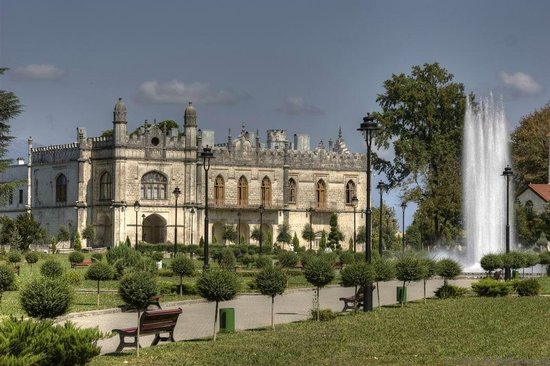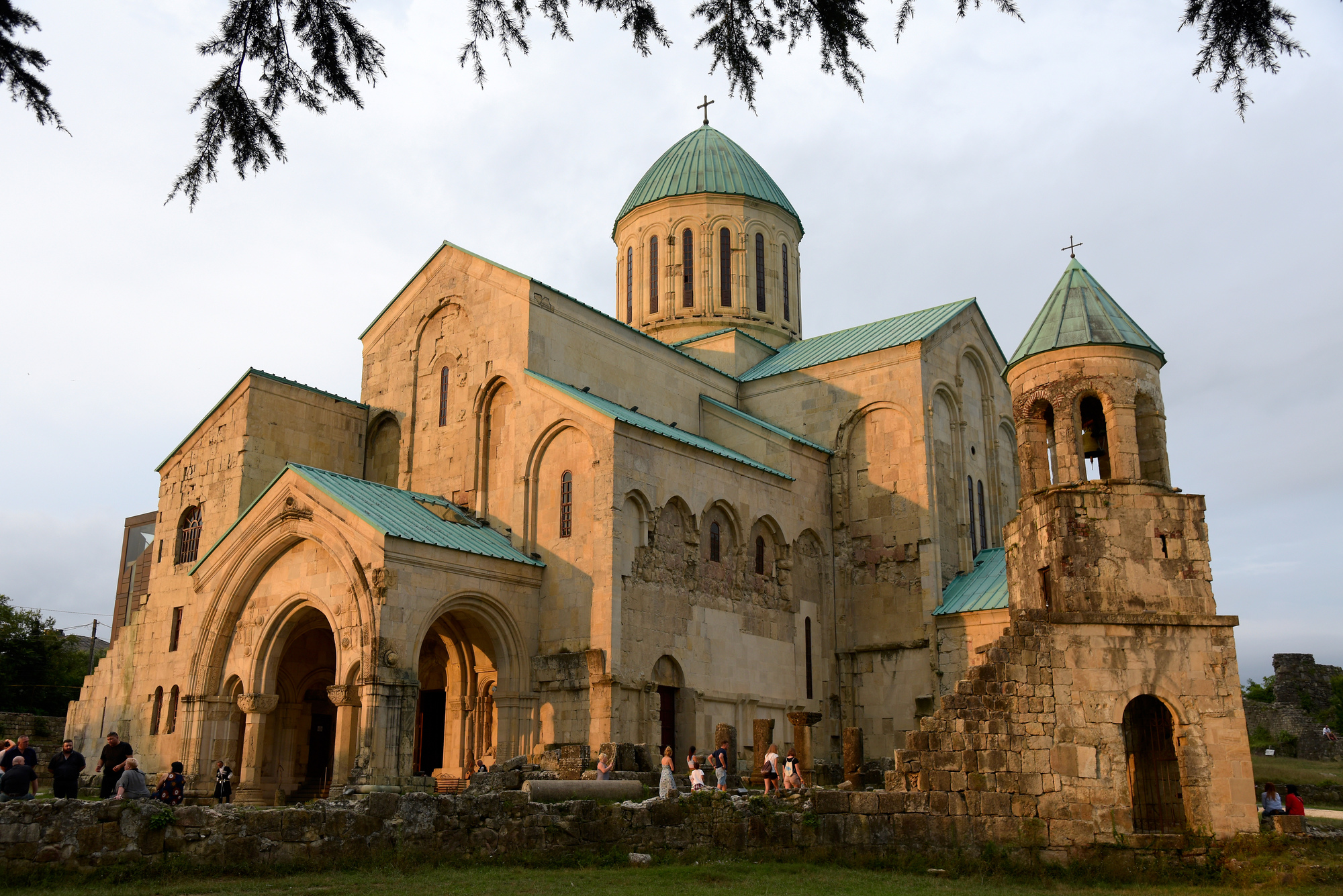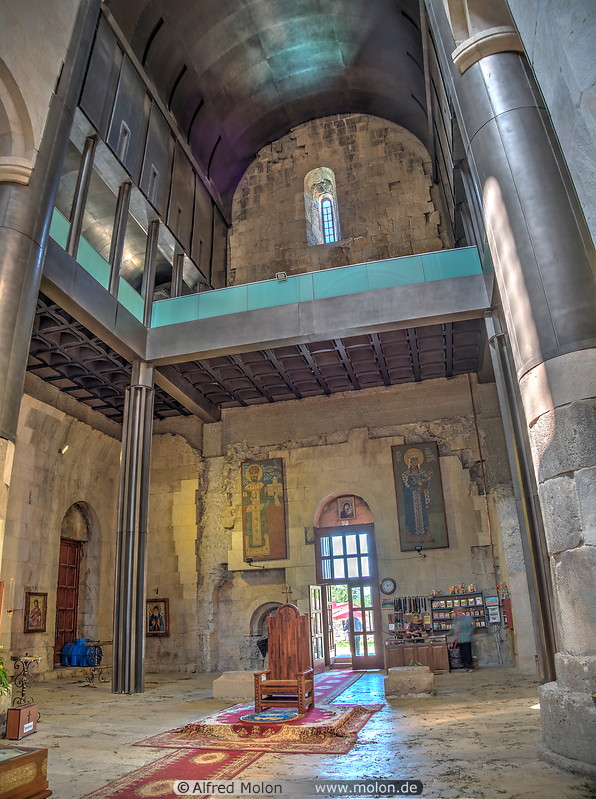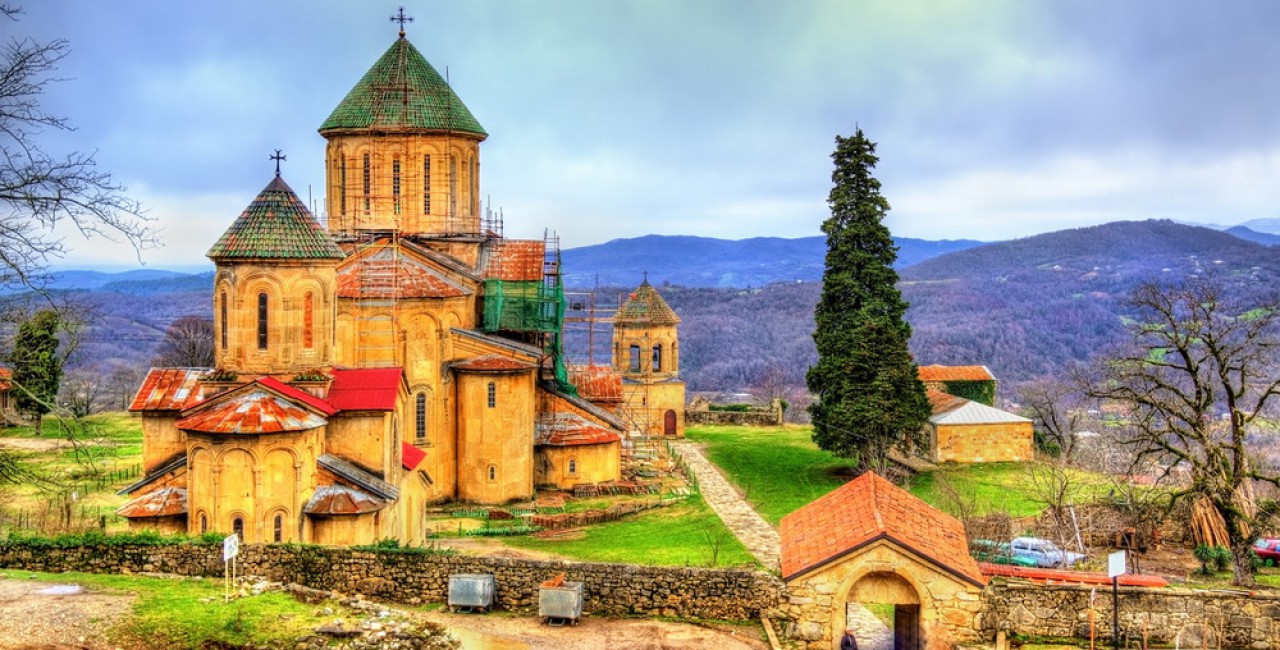Georgia – Imereti, Svaneti, Samtskhe Javakheti, Guria (Kutaisi, Poti) November 19-20, 2019
COLCHIS WETLANDS and FORESTS. A Tentative WHS (24/10/2007), this approximately 74, 826 ha area is one of the last remains of the landscape belt, rich in tropical and sub-tropical habitats, that existed some ten million years ago and stretched as an almost unbroken line over the vast Eurasian continent. It has unique biodiversity, wetlands and forest ecosystems, high endemism and rich tertiary period relics of geological and palaeontological importance.
The territory is cut by many bog-type small stagnant rivers (Pichori, Kukani, Dedabera, Tkhorina, Tsia, Tsiva, Churia, Munchia, Mukhurjina) and lakes (Paleastomi, Patara Paleastomi, Imnati, Parto Tskali). Peat bogs (Anaklia, Churia, Nabada, Imnati, Maltakva, Grigoleti and Pichori) of ancient undisturbed peat layers are located in the coastal plain. The thickness of the peat layers in certain places exceeds 12 meters with the main mass of peat subsided below sea level.
The warm, humid climate and the dense water network have contributed to a rich and diverse plant community. The coastal peat bogs are boreal sphagnum mosses with alpine rhododendrons. In the swamped and wetland forests, alongside the peat bogs, are evergreen undergrowth and aquatic plants in the lakes, swamp rivers and bogs. The vegetation of the narrow coastal zone’s sandy dunes are typical salt-loving, xerophytes and ephemeral vegetation. Uniqueness relic and endemic species include Alnus barbata, Pterocarya pterocarpa, Quercus imeretina, Quercus hartwissiana, and Trapa.
The coastal zone lies along one of the main routes of migration of waterfowl and waders of Africa and Eurasia. Over 194 different bird species are found within the region, including 21 migratory birds. The Black Stork, Crane and Great White Egret are on the verge of extinction and included in the Red Data Book of Georgia. The National Park and Kolkheti lowlands has the legendary Colchis pheasant. The park swamps, swamp rivers, lakes and wetland forests contain endangered species, such as roe deer, boar, otter, Triturus vittatus, Emys orbicularis, Elaphe longisima. The marine area provides a comparatively undisturbed habitat for dolphins (Delphinus delphis, Tursiops truncates, Phocoena phocoena).
Similar forests exist only in Manchuria, China and Japan. In America, such forests were extirpated 400 years ago and now only secondary forests exist. These are historically similar but with differences in species and plants, zones and sub-forests.
Kolkheti National Park.
POTI
Georgian Black Sea coast including Poti are in the NM “XL” series.
Giorgi Chitaia Museum of Colchean Culture of Poti. Even though it has a very nice metal sign by the door, the building is completely derelict. It doesn’t appear to have been open for some time.
On the 60 km drive to Zugdidi near the Abkhazia border, there were many interesting things to see. All continued throughout the north of Georgia.
Free Range Animals. I have never seen such an array of domesticated animals on a road:
Pigs. Mostly white, but one black and a few white with black spots. I even saw two having sex, a first for me with pigs. Some males had an odd triangle of thin logs around their neck – pig birth control?
Cows. Free range and occasionally led or herded along the side of the road.
Horses. Some free range, a few pulling carts, but one on a halter led by the tiniest dog.
Ducks and Chickens.
Goats.
Dogs. Georgia has a dog problem with bands of stray dogs. I was attacked in Batumi.
Elevated Gas Lines. Several towns had yellow gas lines 4m off the ground lining both sides of the highway. The main pipe had many supporting pipes and small feeder pipes with meters leading off to individual houses – cheap and easy to maintain but unbelievably unattractive.
ZUGDIDI
Dadiani Palace Museum. In a nice park with, grass, manicured trees and a grand fountain, there are 3 buildings here: a 2-story stucco “palace” with no furniture, a Russian Orthodox church (square on cross with plain grey walls, a central dome, several framed icons and mass with a priest in his monotonous chant, another with a candle and another with a censor with bells) and a grand stone castle with a crenellated roofline – the museum. There are no explanations but everything is labeled in English. From what I could figure out, this was the palace of Adria Dadiani (1850-1910). He won a chess tournament in Milan.

Go up the stairs to the second floor to the exhibits: portraits, a few large paintings, many framed prints, pistols, swords, a library, painted portraits, a Napoleon I room, and furniture. GEL5
UPPER SVANETI WHS
Preserved by its long isolation, the Upper Svaneti region of the Caucasus is an exceptional example of mountain scenery with medieval-type villages and tower houses, ecclesiastical architecture and arts. The mural paintings are outstanding examples of Renaissance painting in Georgia.
The property occupies the upper reaches of the Lnguri River Basin between the Caucasus and Svaneti ranges, a natural environment of gorges and alpine valleys and a backdrop of snow-covered mountains. It consists of several small villages dominated by the towers and situated on the mountain slopes.
The village of Chazhashi in the Ushguli community, situated at the confluence of the lnguri and Black Rivers, has more than 200 medieval tower houses, churches and castles reflecting the continued dwelling and building traditions of local Svan people. They were used both as dwellings and as defence posts against the invaders who plagued the region.
The origins of Svaneti tower houses go back to prehistory. These towers usually have three to five floors, and the thickness of the walls decreases, giving the towers a slender, tapering profile. The two-storied houses have a ground floor of a single hall with an open hearth and accommodation for both people and domestic animals, the latter being separated by a wooden partition, which is often lavishly decorated. A corridor annex helped with the thermal insulation of the building. The upper floor was used by the human occupants during summer and also served as a store for fodder and tools. A door at this level provided access to the tower, which was also connected to the corridor that protected the entrance. The houses were used both as dwellings and as defence posts against the invaders who plagued the region.
The geographical location has contributed to preserving the local intangible heritage – traditions, customs, beliefs, rituals of everyday life, language and folklore of the Svan community. The harsh environment precluded access during long winter periods. Inappropriate repair techniques used to maintain traditional structures often challenge the authenticity of material and the state of conservation. The property has been designated as Ushguli-Chazhashi Museum Reserve since 1971. The individual architectural elements as well as entire villages of the Ushguli community (Chazhashi, Jibiani, Chvibiani and Murk’meli) remain listed as national monuments. There is no management plan enforced. The local population and its traditional system of community management remain the key factors in property management.
I had put in Upper Svaneti into Google Maps without putting in the actual towns. The last 4 km was a rough gravel road that ended in a 4WD road for walking only. A sign listed the destinations: Kinnahonra Campsite 10.3kms, Khaishi 61.5kms and 30’ 20”, Mukhui 67.3kms and 34’ 15”. I then put Chazhashi – 181 km to the northeast and 4 hours and 48 minutes to drive through the rugged Caucasus Mountains!
I didn’t go here but post this for information.
So if you want to see this WHS, enter the villages, not the region. It appears that you can access the area from the west or south. What a waste of time.
By the time I was back on the right road, this must have taken 3 hours – narrow roads, a detour, a funeral and a wealth of animals on the road. There were a lot more pigs on this section of road and as I progressed, cattle were everywhere.
KUTAISI
Kutaisi is the third-most populous city in Georgia, traditionally, second in importance, after the capital city of Tbilisi. Situated 221 kilometres (137 miles) west of Tbilisi, on the Rioni River, it is the capital of the western region of Imereti. Historically one of the major cities of Georgia, it served as the capital of the Kingdom of Georgia in the Middle Ages and later as the capital of the Kingdom of Imereti. From October 2012 to December 2018, Kutaisi briefly was the seat of the Parliament of Georgia to decentralize the Georgian government.
House of Parliament. In the NM “Modern Architecture Buildings”, was constructed from 2011 to 2012, 231 kilometres (144 mi) west of Tbilisi, the nation’s capital, to house the Parliament of Georgia. It was the main seat of the newly elected Parliament in October 2012 until the legislature moved back to Tbilisi in January 2019.
The exterior of the building is dominated by a 100-metre (330 ft) by 150-metre (490 ft) oval-shaped great glass and steel dome ploughed by a roof-like concrete element that rests on the vault. It was constructed on the initiative of then-President of Georgia Mikheil Saakashvili on the site of a memorial to Soviet soldiers of World War II; the monument was demolished with explosives to free space for the construction in December 2009, accidentally killing two people, a mother and a daughter. The government, during the building’s construction, promoted it as a symbol of Georgia’s bright, democratic future. Its location in Kutaisi was touted as a boost for the regional economy there as well as a way to knit the country closer together. Critics state that the building is a waste of money and that having Parliament in Kutaisi, while the rest of the government remains in Tbilisi, is inefficient.
After Saakashvili’s term in office expired, the new government of the Georgian Dream coalition decided to move all parliamentary activities back to Tbilisi in January 2019.
Museum of Georgian Sport. The most popular sports in Georgia are football, basketball, rugby union, wrestling, judo, and weightlifting. Historically, Georgia has been famous for its physical education; the Romans were fascinated with Georgians’ physical qualities after seeing the training techniques of ancient Iberia. Wrestling remains a historically important sport of Georgia, and some historians think that the Greco-Roman style of wrestling incorporates many Georgian elements.
Within Georgia, one of the most popularized styles of wrestling is the Kakhetian style. There were several other styles in the past that are not as widely used today. For example, the Khevsureti region of Georgia has three different styles of wrestling. Other popular sports in 19th century Georgia were polo, and Lelo, a traditional Georgian game later replaced by rugby union.
The first and only race circuit in the Caucasian region is located in Georgia. Rustavi International Motorpark originally built in 1978 was re-opened in 2012 after total reconstruction costing $20 million. The track satisfies the FIA Grade 2 requirements and currently hosts the Legends car racing series and Formula Alfa competitions.
Basketball was always one of the notable sports in Georgia, and Georgia had a few very famous Soviet Union national team members, such as Otar Korkia, Mikheil Korkia, Zurab Sakandelidze and Levan Moseshvili. Dinamo Tbilisi won the prestigious Euroleague competition in 1962. Georgia had five players in the NBA: Vladimir Stepania, Jake Tsakalidis, Nikoloz Tskitishvili, Tornike Shengelia and current Golden State Warriors center Zaza Pachulia. Other notable basketball players are two times Euroleague champion Giorgi Shermadini and Euroleague players Manuchar Markoishvili and Viktor Sanikidze. Sport is regaining its popularity in the country in recent years. Georgia national basketball team qualified to EuroBasket during the last three tournaments since 2011.
Kutaisi State Historical Museum. Kutaisi was the capital of the ancient Kingdom of Colchis in the sixth to fifth centuries BC. It is believed that, in Argonautica, a Greek epic poem about Jason and the Argonauts and their journey to Colchis, author Apollonius Rhodius considered Kutaisi their final destination as well as the residence of King Aeëtes.
Later it was the capital of the kingdom of Lazica until being occupied briefly by the Arabs. An Arab incursion into western Georgia was repelled by Abkhazians jointly with Lazic and Iberian allies in 736, towards c.786, Leon II won his full independence from Byzantine and transferred his capital to Kutaisi, thus unifying Lazica and Abasgia via a dynastic union. The latter led to the unification of the Georgian monarchy in the 11th century.
From 1008 to 1122, Kutaisi served as the capital of the United Kingdom of Georgia, and from the 15th century until 1810, it was the capital of the Imeretian Kingdom. In 1508, the city was conquered by Selim I, who was the son of Bayezid II, the sultan of the Ottoman Empire.
During the 17th century, Imeretian kings made many appeals to the Russian Empire to help them in their struggle for independence from the Ottomans. All these appeals were ignored as Russia did not want to spoil relations with Turkey. Only in the reign of Catherine the Great, in 1768, were troops of General Gottlieb Heinrich Totleben sent to join the forces of King Heraclius II of Georgia, who hoped to reconquer the Ottoman-held southern Georgian lands, with Russian help. Totleben helped King Solomon I of Imereti to recover his capital, Kutaisi, on August 6, 1770.
Finally, the Russian-Turkish wars ended in 1810 with the annexation of the Imeretian Kingdom by the Russian Empire. The city was the capital of the Kutaisi Governorate, which included much of west Georgia. In March 1879, the city was the site of a blood libel trial that attracted attention all over Russia; the ten accused Jews were acquitted.
Kutaisi was a major industrial center before Georgia’s independence on 9 April 1991. Independence was followed by the economic collapse of the country, and, as a result, many inhabitants of Kutaisi have had to work abroad. Small-scale trade prevails among the rest of the population.
In 2011 Mikheil Saakashvili, the president of Georgia, signed a constitutional amendment relocating the parliament to Kutaisi. On 26 May 2012, Saakashvili inaugurated the new Parliament building in Kutaisi. This was done to decentralize power and shift some political control closer to Abkhazia, although it has been criticized as marginalising the legislature, and also for the demolition of a Soviet War Memorial formerly at the new building’s location.
Bagrati Cathedral. Built in the 10th and 11th centuries, an inscription stated that the floor was laid in 1003. King Bagrat III’s (975-1014) grave was inside. Historically it was a symbol of a united Georgia. The Ottomans invaded in 1692 and blasted the temple, plundered the treasures and stole the marble columns (returned in 1770 by King Solomon I). It had a 3-storied residential tower for the bishops, ornately carved gates, frescoes of the Virgin and colourful tiled floor.
A complete ruin at the beginning of the 20th century (only wall remnants remaining), it was mostly reconstructed from 1930-90s and completed from 2006-12 with a copper roof. The reconstruction is evident throughout with wall remnants, floors and gates incorporated into the new structure. The ancient bell tower separate from the church appears original. The portal has a few old stones, capitals, columns and crosses on the façade but most is a reconstruction. Inside it is a square on the cross with 6 columns supporting the very high dome and narthex. A glass floor covers the original cement-patterned floor in the altar. Some of the icons are tremendous, especially the gold/gems/enamel St George and the Dragon.
It was WHS listed in 1994.


Gelati Monastery, Motsameta. A World Heritage Site (1994), this is about 9kms north of central Kutaisi high on the side of a mountain.
Founded by King Davit Agmashenebeli (1089-1125) in 1106, it has been eulogized as the “New Athens” and “the Second Jerusalem” as one of the greatest spiritual and cultural centers of Georgia in the Middle Ages.
It functioned as an academy with outstanding Georgian scientists, philosophers and theologians. Since the 14th century, it has been an Episcopal Cathedral. The apse has a standing Virgin holding the child with archangels on her sides dated to 1125-1130. In the western narthex are 12th-century murals depicting seven ecumenical councils. Most murals date to the 2nd half of the 16th century. Other buildings date from the 12th-14th centuries: the Academy, Church of St George (interior painted in the 16th century, the 2-storied Church of St Nicholas and the bell tower, one of the oldest in Georgia. The monastery was the burial vault of Georgian kings with the grave of King David on the South gate. The yellow stone church has wonderful green ceramic tiles on the roofs. Outside is a bell tower, another tower and a chapel. Enter the narthex with uncovered and faded frescoes, best under a small dome. A square-on-cross design, the ceilings and dome are very high with frescoes covering all the walls, dome and ceilings. Most are slightly faded but many of the faces are clear and intricate with red dominating but blue backgrounds in the apse and top of the arches. The iconostasis is simple wood but a carved door. Several icons are on wooden stands. Restoration is ongoing with a scaffold against the north wall and most of the outside where the roof tiles are being replaced.
I was alone again in another WHS. A priest was puttering around lighting all the candles.


Borjomi-Kharagauli National Park. This is a protected area in central Georgia in the Lesser Caucasus, southwest of Tbilisi. Its ecoregion is that of the Caucasus mixed forests. One of the largest national parks in Georgia, it stretches from the resort of Borjomi to the town of Kharagauli. Together with the adjacent Borjomi Nature Reserve, the total area is 851 square kilometres, i.e. more than 1 % of the total territory of Georgia. The park was founded in 1995 and officially inaugurated in 2001.
Its particular uniqueness is the diversity of geographical and ecological zones, landscapes, historical monuments and rich flora and fauna. The park has a rapidly developing tourist infrastructure.

BORJOMI (pop 10,550)
Borjomi is a resort town in south-central Georgia in the picturesque Borjomi Gorge on the eastern edge of the Borjomi-Kharagauli National Park. The town is noted for its mineral water industry (which is the number one export of Georgia), the Romanov summer palace in Likani, and the World Wide Fund for Nature-site Borjomi-Kharagauli National Park. Borjomi mineral water is particularly well known in those countries which were part of the former Soviet Union; the bottling of mineral water is a major source of income for the area. Because of the supposed curative powers of the area’s mineral springs, it is a frequent destination for people with health problems.
Romanov Palace (Likani Palace), is a beautiful example of architecture built from 1892- 95. Since then this place on the bank of the Mtkvari River served as a summer holiday residence for the Russian Royal family headed by Grand Duke Nicholai Mikhailovich.
The general architectural style of the Palace is described as Mauritian, with each of the sides of the villa having a different form and shape. The major feature of this type of architecture is that the European (mostly French) design is adapted to suit humid climates, and includes elements that are made to keep residents cool and dry.
It houses a unique collection of different Royal antiques such as a table that was presented to Romanov’s by French emperor Napoleon, a chair presented by an Iranian Sheikh, historical table assembled personally by Pyotr the First from nut tree roots, the billiard table, Russian oven with the images of different animals of Borjomi gorge, etc. Central entrance arch of the Palace is decorated with a porcelain parrot that turns around whenever there is the air stream like the bird is greeting visitors.
One of the major attractions within the Palace is the private office of the Grand Duke, which was later occupied by Joseph Stalin, who used to spend here his summer vacations as well. The “butterfly” bedroom and a wonderful garden are also nice.
 3 3 km west of central Borjomi, it is enclosed by a high cement wall and is private. Nothing can be seen from the gate.
3 3 km west of central Borjomi, it is enclosed by a high cement wall and is private. Nothing can be seen from the gate.
GO TO Georgia – Kartli Shida/Kvemo, Mtskheta, Kakheti (Tbilisi, Gori)
After going to Azerbaijan and Armenia, I returned to Georgia to see these before heading on to Turkey.
Dmanisi Hominid Archaeological Site (24/10/2007)
Nakalakevi: Ruins of Tmogvi Fortress (Sight)
Vardzia-Khertvisi (24/10/2007)
